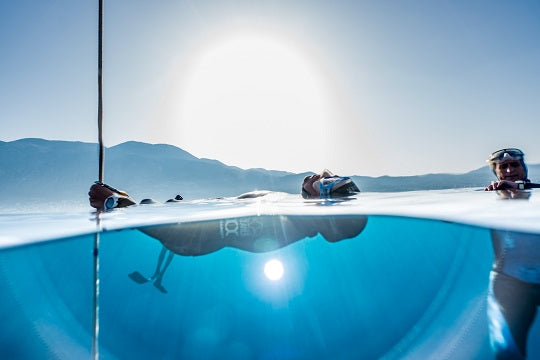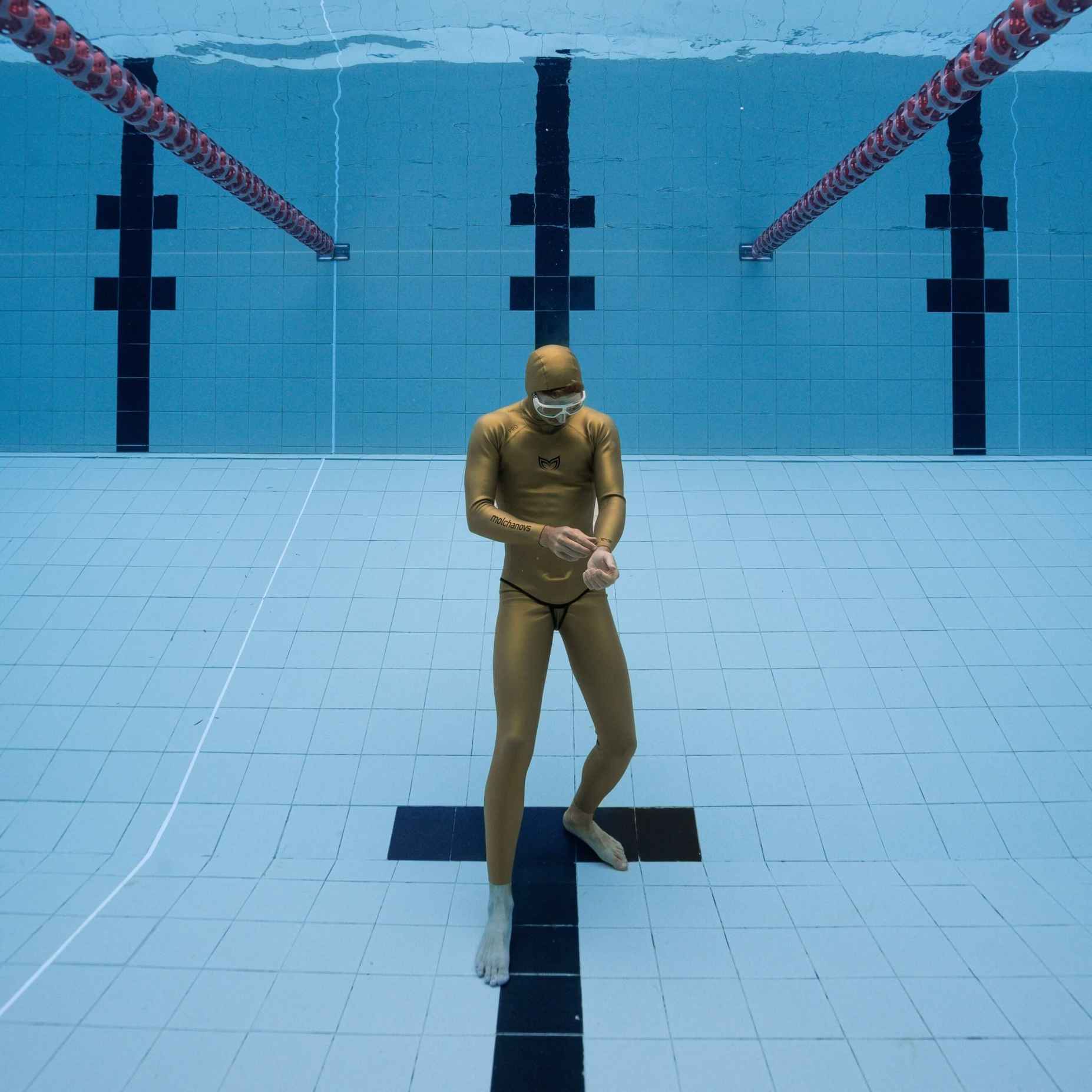Cyprus Freediving Stories: The Line

Asya Kleshchevnikova
Sports Columnist and Head of Customer Service & International Sales
asya@molchanovs.com
molchanovs.com
Kristina Zvaritch
Editor
It is the third Monday before the 27th AIDA World Championship, which means that it is time for our next Cyprus freediving story.
(Reminder: Every week before the 27th AIDA World Championship, we will post a story that took place in Freediving history. Our first story was about the first international competition of Natalia Molchanova, which you can find here. The second story is about Carlos Coste - the first man who officially managed to break the 100m/328ft barrier in CWT, which you can read here).
The new story is about miscalculated dive line depths that occurred in Cyprus in 2015 and in several other competitions. We want to start with a very well-known incident, which took place at the 2015 AIDA Depth World Championships Pre-Competition. At the time, freedivers did not guess beforehand that it was the only day in nine years that anyone would attempt to surpass the CWT World Record set by Alexey Molchanov in 2012. Since the year Alexey set that particular record, he has added 5m/16ft to that performance, resulting in the current incredible depth of 131m/430ft. He has never loaned the title of World Record Holder and deepest competitive freediver to anyone else.

Therefore, we will forever remember the day in September 2015 when Guillaume Néry of France made the effort to win that very title. On the first day of competition, Guillaume made a smooth dive to the depth of 126m/413ft. Inspired by his success, the athlete announced the much deeper depth of 129m/423ft for the next competition day. At the beginning, Guillaume recalled that everything was going well, and he was sure that he could manage the depth. However, 10m/33ft before the surface, the athlete blacked out. As it was only discovered afterwards, due to a piece of tape (depth marker) falling off the dive line without anyone noticing, the dive line was incorrectly marked and set to 139m/456ft. At these depths, even a 1m/3ft increase in depth can demand months of intense training. In this case, the freediver had unknowingly and unintentionally dived a total of 10m/33ft deeper. It could have cost him his life, but fortunately, Guillaume was in very good shape and survived with a minor injury.

We should also bear in mind that these competitions and the following 2015 AIDA Depth World Championship occurred just a few months after the tragic loss of Natalia Molchanova. This was a time when many freedivers began to revise their attitude toward the sport, considering that it might not be so risk-free if even the best of the best could be lost. Besides, athletes were missing the presence of Natalia, who was a teacher to most of them and an example to freedivers everywhere.
It also was one of the reasons why Guillaume Néry has stopped competing. Presently, he maintains focus on his artistic projects and family. However, we are still hoping to welcome him back to competition one day.
Unfortunately, Guillaume’s accident was not the only case of an incorrectly set dive line. During the next year’s 2016 AIDA Team World Championship, a similar mistake occurred - twice.
For Guillaume Bussiere of France, who had announced 101m/331ft depth in CWT, the dive line was mistakenly set to 80m/262ft. He dived to 81m/266ft successfully, but according to competition rules, judges were obliged to count the full 101 points, which they did. However, the French team declined to accept that amount, instead requesting to count the 81 points Guillaume earned in actuality. In our opinion, this was an exceptional example of noble respect toward the other teams, which we would like to take a moment to praise. We wish that now, as freediving competitions become more and more intense, athletes maintain that spirit of sportsmanship and fair play.
The second incident occurred during the dive of Timothy Oehmigen of Germany. Consequently, it was due to the mistaken setting of Guillaume Bussiere’s dive line. Timothy was attempting 85m/279ft in CWT when he started his dive. Only when he was already in the zone of negative buoyancy did the judges realize that the dive line, once again, was set at the incorrect depth. Upon realization, the judges decided to move the dive line to the correct depth while the athlete was still diving, hoping that the athlete would not notice that the dive line was in motion with his descent. However, during his freefall, Tim was following the line with his hand and was shocked when felt that the dive line was being lowered. Showing tremendous composure, he made the only right decision there was in that particular situation - he turned and began his ascent at 56m/184ft. On the surface, he protested and was allowed another attempt 80 minutes later during the break. On the second attempt, Timothy completed his dive successfully and without any further incident.
We spoke with well-known Russian AIDA judge and competition manager Alexey Serov on this matter and learned what has changed since to minimize the risk of similar mistakes happening in modern-day freediving competitions.

First, the number of people who are responsible for all of the pre-dive equipment setup has increased. Previously, in most cases, only a single person alone was responsible for these challenging jobs, and no clear instructions or protocols were established. Now, the person who sets up the counter ballast system and measures out the dive line is responsible for the setting of it.
The next step was implementing a triple check of the set depth. The person who lowers the dive line from the diving platform or boat announces the depth, while judges in the water confirm that the corresponding depth mark passed. Then a member of the safety team dives to the nearest rounded-number rope marking with a dive computer and checks that it is at the correct depth (for example, an athlete announced 78m/256ft, which means that a safety dives to nearest mark with 70m/230ft and their watch should read that they are at 8m/26ft depth).
Besides, electrical tape is no longer used for rope marking. A proper dive line should be marked with a special marker, which cannot be removed and does not suddenly vanish after several dives. The main reason for the incidents described above was that electrical tape depth marks accidentally came off in the water, resulting in a completely different depth reading. In addition, all the depth marks are now clearly visible with the number written on the dive line every 5m/16ft.
With this story, we want to emphasize that not only have athletes came a long way in the history of freediving with reaching incredible depths, but the judges, safeties, and teams of managers responsible for competition organization have also made much progress. Of course, mistakes can still happen. However, modern freediving competitions are much safer and more comfortable for athletes than even competitions dating back as early as five years ago. Behind each successful dive is a large number of people that put in tremendous work to keep this sport safe for all. Freediving history cannot be written without any of these individuals.
We believe that it is our mission to remember these historical events that gave our sport new perspectives and depths. For those who would like to memorialize this important historical freediving location, we are preparing Cyprus special edition equipment, which will include monofins, bifins, and t-shirts with unique and subtle designs devoted to Cyprus.
We are thrilled to present to you the design of our special edition gear. It reflects the depth map near Limassol, Cyprus and contains the exact location where the 27th AIDA World Championship will take place. Check it out, and if you want to possess this unique piece of equipment, make sure to save the date for its launch!

Cyprus special edition equipment will only be available for order during the AIDA Depth World Championship, which will take place September 20-30. Stay tuned and don't miss your chance to get a limited edition piece of equipment.




Leave a comment